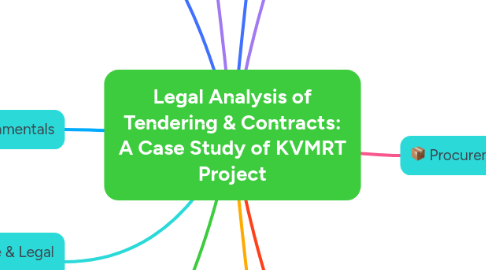
1. Project Overview
1.1. Purpose
1.1.1. Improve public transport, reduce vehicle dependency, and enhance urban mobility.
1.2. Scale
1.2.1. Three MRT lines planned, with MRT Line 1 (Sungai Buloh–Kajang) completed in 2017, spanning 51 km and 31 stations.
1.3. Stakeholders
1.3.1. MRT Corp (client), MMC-Gamuda JV (contractor), and various consultants and government entities.
1.4. Technology
1.4.1. Use of advanced Tunnel Boring Machines (TBMs) and the Design & Build (D&B) procurement method.
2. 📜 Standard Forms of Contract
2.1. FIDIC
2.1.1. The project primarily used a modified FIDIC Red Book contract, customized for Malaysian legal and operational contexts.
2.1.2. FIDIC contracts are widely accepted in international construction and are suitable for D&B arrangements with clear risk allocation clauses.
2.2. PAM
2.3. CIDB Forms
3. 🔧 Engineering Fundamentals
3.1. Construction Sequence affects delay claims
3.2. Risk in underground Tunneling
4. 📚 Research Literature & Legal Framework
4.1. Academic research highlights the importance of aligning procurement strategy with project complexity (Ng, 2014; Zakaria & Haron, 2016).
5. 🔍 Abstract Thinking
5.1. What if MRT Corp had opted for traditional procurement?
5.1.1. Likely, risk fragmentation and slower delivery.
5.2. Ethical considerations arise in selective tendering
5.2.1. Balancing fairness and quality assurance.
6. Introduction
6.1. The Klang Valley Mass Rapid Transit (KVMRT) project represents one of Malaysia’s most ambitious infrastructure undertakings, aimed at transforming the public transportation network across the Greater Kuala Lumpur area. This report analyzes the legal dimensions of tendering and contractual practices involved in the KVMRT project, focusing on procurement strategy, forms of contract, stakeholder responsibilities, and legal implications.
7. 📑 Types of Tender
7.1. Open Tender
7.2. Selective Tender
7.2.1. Selective Tendering was adopted to ensure experienced and capable contractors could manage the high-risk nature of underground works
7.2.2. This method allowed MRT Corp to shortlist pre-qualified bidders, increasing quality and reducing risks.
7.3. Negotiated Tender
8. 📦 Procurement Methods
8.1. Traditional
8.2. Design & Build
8.2.1. Design & Build (D&B) was chosen to accelerate project delivery and allocate more design responsibility to the contractor.
8.2.2. The D&B method reduced fragmentation and encouraged integrated project delivery, but also shifted more legal and technical risk to the contractor.
8.3. Management Contract
9. 👥 Roles & Responsibilities
9.1. Client
9.1.1. MRT Corp
9.1.1.1. Responsible for overall oversight and public accountability.
9.2. Contractor
9.2.1. MMC-Gamuda JV
9.2.1.1. Main contractor, tasked with both design and execution, particularly for tunneling works.
9.3. Consultant
9.3.1. PDP
9.3.1.1. Assisted in project management, quality assurance, and compliance with national regulations.
10. ⚖️ Legal Issues
10.1. Variation Orders
10.1.1. Disputes on changes in scope and pricing mechanisms, requiring clear contractual clauses and timely approvals.
10.2. Risk Allocation
10.2.1. Geotechnical risks (ground conditions during tunneling) raised contractual and liability issues.
10.3. Liquidated & Ascertained Damages (LAD)
10.3.1. MRT Corp sought LAD for late completion, leading to disagreements with contractors.
10.4. Extension of Time (EOT)
10.4.1. Disputes over whether delays were excusable or compensable.
